Sony VAIO VGN-FS215SR, VAIO VGN-FS285B, VAIO VGN-FS215Z, VAIO VGN-FS285M, VAIO VGN-A497XP User Guide
...
N
User Guide
Personal Computer
V G N - A s e r i e s / V G N - F S s e r i e s

|
n N |
|
2 |
Contents |
|
Before Use ............................................................................................................................................................................... |
6 |
Notice ................................................................................................................................................................................. |
6 |
ENERGY STAR ..................................................................................................................................................................... |
7 |
Documentation ................................................................................................................................................................... |
8 |
Ergonomic Considerations ............................................................................................................................................... |
11 |
Getting Started ....................................................................................................................................................................... |
13 |
About the Indicator Lights ................................................................................................................................................ |
14 |
Connecting a Power Source ............................................................................................................................................ |
15 |
Using the Battery Pack..................................................................................................................................................... |
16 |
Shutting Down Your Computer Safely ............................................................................................................................. |
23 |
Using Your VAIO Computer ................................................................................................................................................... |
24 |
Using the Keyboard.......................................................................................................................................................... |
25 |
Using the Touch Pad........................................................................................................................................................ |
27 |
Using Special-function Buttons ........................................................................................................................................ |
28 |
Using the Optical Disc Drive ............................................................................................................................................ |
30 |
Using the TV Function (on Selected Models Only) .......................................................................................................... |
38 |
Using PC Cards ............................................................................................................................................................... |
39 |
Using the Memory Stick Media ........................................................................................................................................ |
43 |
Using the Internet............................................................................................................................................................. |
47 |
Using Wireless LAN (WLAN) ........................................................................................................................................... |
48 |
Using the Bluetooth Functionality (on Selected Models Only) ......................................................................................... |
57 |

|
n N |
|
3 |
Using Peripheral Devices....................................................................................................................................................... |
63 |
Connecting a Port Replicator ........................................................................................................................................... |
64 |
Using the Mouse (on Selected Models Only)................................................................................................................... |
77 |
Connecting External Speakers......................................................................................................................................... |
81 |
Using the Remote Commander........................................................................................................................................ |
86 |
Connecting an External Display ....................................................................................................................................... |
89 |
Selecting Display Modes.................................................................................................................................................. |
97 |
Using the Multiple Monitors Function ............................................................................................................................. |
100 |
Connecting an External Microphone .............................................................................................................................. |
104 |
Connecting a Universal Serial Bus (USB) Device.......................................................................................................... |
105 |
Connecting a Printer ...................................................................................................................................................... |
108 |
Connecting an i.LINK Device ......................................................................................................................................... |
110 |
Connecting to a Network (LAN) ..................................................................................................................................... |
112 |
Customizing Your VAIO Computer ...................................................................................................................................... |
114 |
Setting the Password ..................................................................................................................................................... |
115 |
Setting Up Your Computer with VAIO Control Center.................................................................................................... |
120 |
Using the Power Saving Modes ..................................................................................................................................... |
122 |
Managing Power with VAIO Power Management .......................................................................................................... |
127 |
Setting Up Your Language with Windows XP Professional ........................................................................................... |
131 |
Configuring Your Modem ............................................................................................................................................... |
134 |
Setting a Sony Wallpaper............................................................................................................................................... |
137 |
Installing and Upgrading Applications ............................................................................................................................ |
138 |
Managing Drivers ........................................................................................................................................................... |
143 |

|
n N |
|
4 |
Upgrading Your VAIO Computer.......................................................................................................................................... |
154 |
Adding and Removing Memory...................................................................................................................................... |
155 |
Precautions .......................................................................................................................................................................... |
169 |
On Handling the LCD Screen......................................................................................................................................... |
170 |
On Using the Power Source........................................................................................................................................... |
171 |
On Handling Your Computer.......................................................................................................................................... |
172 |
On Handling Floppy Disks.............................................................................................................................................. |
174 |
On Handling Discs ......................................................................................................................................................... |
175 |
On Using the Battery Pack............................................................................................................................................. |
176 |
On Using Headphones................................................................................................................................................... |
177 |
On Handling Memory Stick Media.................................................................................................................................. |
177 |
On Handling the Hard Disk ............................................................................................................................................ |
178 |

|
n N |
|
5 |
Troubleshooting ................................................................................................................................................................... |
179 |
Troubleshooting the optical disc drive............................................................................................................................ |
180 |
Troubleshooting PC Cards............................................................................................................................................. |
184 |
Troubleshooting the modem .......................................................................................................................................... |
184 |
Troubleshooting the Bluetooth functionality ................................................................................................................... |
186 |
Troubleshooting Wireless LAN....................................................................................................................................... |
189 |
Troubleshooting Power Management ............................................................................................................................ |
192 |
Troubleshooting External Displays................................................................................................................................. |
193 |
Troubleshooting Sound (Speaker) ................................................................................................................................. |
195 |
Troubleshooting Sound (Microphone)............................................................................................................................ |
196 |
Troubleshooting Floppy Disks........................................................................................................................................ |
198 |
Troubleshooting Printers ................................................................................................................................................ |
199 |
Troubleshooting i.LINK Devices..................................................................................................................................... |
201 |
Support Options ................................................................................................................................................................... |
202 |
Sony Support Information .............................................................................................................................................. |
202 |
e-Support ....................................................................................................................................................................... |
203 |
Trademarks .................................................................................................................................................................... |
205 |

n N
6
Before Use
Before Use
Congratulations on your purchase of this Sony VAIO® computer, and welcome to the on-screen User Guide. Sony has combined leading-edge technology in audio, video, computing, and communications to provide state-of-the-art personal computing.
Notice
© 2005 Sony Corporation. All rights reserved.
This manual and the software described herein, in whole or in part, may not be reproduced, translated, or reduced to any machine-readable form without prior written approval.
Sony Corporation provides no warranty with regard to this manual, the software, or other information contained herein and hereby expressly disclaims any implied warranties or merchantability or fitness for any particular purpose with regard to this manual, the software or such other information. In no event shall Sony Corporation be liable for any incidental, consequential, or special damages, whether based on tort, contract, or otherwise, arising out of or in connection with this manual, the software, or other information contained herein or the use thereof.
Macrovision: This product incorporates copyright protection technology that is protected by U.S. patents and other intellectual property rights. Use of this copyright protection technology must be authorized by Macrovision, and is intended for home and other limited viewing uses only unless otherwise authorized by Macrovision. Reverse engineering or disassembly is prohibited.
In the manual, the ™ or ® marks are not specified.
Sony Corporation reserves the right to make any modification to this manual or the information contained herein at any time without notice. The software described herein is governed by the terms of a separate user license agreement.
Please note that the illustrations in this manual may not necessarily apply to your model. Please see the printed Specifications sheet for the specific configuration of your VAIO computer.

n N
7
Before Use
ENERGY STAR
As an ENERGY STAR Partner, Sony has determined that this product meets the ENERGY STAR guidelines for energy efficiency.
The International ENERGY STAR Office Equipment Program is an international program that promotes energy saving through the use of computers and their office equipment. The program backs the development and dissemination of products with functions that effectively reduce energy consumption. It is an open system in which business proprietors can participate voluntarily. The targeted products are office equipment such as computers, displays, printers, facsimiles and copiers. Their standards and logos are uniform among participating nations.
ENERGY STAR is a U.S. registered mark.

n N
8
Before Use
Documentation
Your Documentation contains printed information and user guides to read on your computer.
Guides are provided in PDF format, which you can easily browse through and print out.
The My Club VAIO portal is a perfect starting point to using your VAIO computer — a comprehensive collection of everything you need to get the most from your computer.
The user guides are collected under Documentation, which can be shown as follows:
1Click Start and then the My Club VAIO icon  .
.
2Click Documentation.
3Select the guide you want to read.
You can manually browse to the user guides by going to My Computer > VAIO (C:) (your C drive) > Documentation > Documentation and opening the folder for your language.
You may have a separate disc for the documentation of bundled accessories.
Printed Documentation
Specifications sheet — Contains a table of specifications, a list of bundled software, an overview of all controls and ports and, on the reverse side, a guide to setting up your VAIO computer.
Troubleshooting Guide — Contains solutions to common problems.
Recovery Guide — Contains an explanation of how to recover your computer's system if you need to.
Booklets containing the following information: Sony Guarantee conditions, Safety Regulations, Modem Regulations and
Wireless LAN Regulations.

n N
9
Before Use
Non-printed Documentation
My Club VAIO
In My Club VAIO you can find:
Documentation, which gives you:
Access to the User Guide. This manual explains the features of your VAIO in detail, how to use these features confidently and safely, connect peripheral devices and more.
Access to Help and Training. This is the portal of VAIO Help and Support Center.
Important information about your computer, in the form of notices and announcements.
In My Club VAIO you can also find:
Accessories
Want to expand the capabilities of your VAIO? Click on this icon and have a look at your compatible accessories.
Software
Feeling creative? Click this icon for an overview of your software and check out our upgrade options.
Wallpapers
Click this icon and check out our most popular Sony and Club VAIO wallpapers.
Links
Click this icon and check out our most popular Sony and Club VAIO web sites.
Help and Support Center
Help and Support Center is a comprehensive resource for practical advice, tutorials, and demonstrations to help you learn to use Microsoft Windows XP and your VAIO.
Use the Search feature, Index, or table of contents to view all Windows Help resources, including those that are on the Internet. To access Help and Support Center, click Start and then Help and Support.

n N
10
Before Use
Further Sources
Consult the Online Help files of the software you are using for detailed information on features and troubleshooting.
Go to www.club-vaio.com to find online tutorials about your favorite VAIO software.
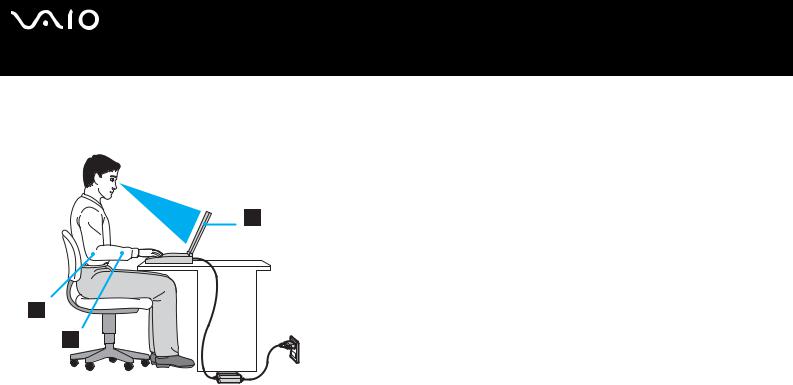
n N
11
Before Use
Ergonomic Considerations
You will be using your computer as a portable device in a variety of environments. Whenever possible, you should attempt to take account of the following ergonomic considerations to both stationary and portable environments:
Position of your computer – Place the computer directly in front of you (1). Keep your forearms horizontal (2), with your wrists in a neutral, comfortable position (3) while using the keyboard, touch pad, or external mouse. Let your upper arms hang naturally at your sides. Have breaks during sessions with your computer. Excessive use of the computer may strain muscles or tendons.
Furniture and posture – Sit in a chair with good back support. Adjust the level of the chair so your feet are flat on the floor. A footrest may make you more comfortable. Sit in a relaxed, upright posture and avoid slouching forward or leaning far backwards.

n N
12
Before Use
Viewing angle of the computer's display – Use the display's tilting feature to find the best position. You can reduce eye strain and muscle fatigue by adjusting the tilt of the display to the proper position. Adjust the brightness setting of the display as well.
Lighting – Choose a location where windows and lights do not create glare and reflection on the display. Use indirect lighting to avoid bright spots on the display. You can also purchase accessories for your display that help reduce glare. Proper lighting adds to your comfort and work effectiveness.
Positioning an external display – When using an external display, set the display at a comfortable viewing distance. Make sure the display screen is at eye level or slightly lower when you are sitting in front of the monitor.

n N
13
Getting Started
Getting Started
This section describes how to get started with using your VAIO computer.
About the Indicator Lights (page 14)
Connecting a Power Source (page 15)
Using the Battery Pack (page 16)
Shutting Down Your Computer Safely (page 23)

|
|
|
n N |
|
|
|
|
14 |
|
|
|
|
Getting Started |
|
|
|
|
|
|
About the Indicator Lights |
||||
|
|
|
|
|
|
Indicator |
|
Functions |
|
|
|
|
|
|
|
Power 1 |
|
Illuminates when the power of the computer is on, blinks in Standby mode, and turns off when the computer is in |
|
|
|
|
Hibernate mode or off. |
|
|
|
|
|
|
|
Battery e |
|
Illuminates when the computer is using battery power, blinks when the battery is running out of power, and double- |
|
|
|
|
blinks when the battery is charging. |
|
|
|
|
|
|
|
Memory Stick Pro/Duo |
Illuminates when data is read from or written to the Memory Stick media. (Do not enter Standby mode or turn off the |
|
|
|
|
|
computer when this indicator is on.) When the indicator is off, the Memory Stick media is not being used. |
|
|
|
|
|
|
|
Optical disc drive |
(VGN-A |
Illuminates when data is read from or written to the optical disc. When the indicator is off, the optical disc is not being |
|
|
used. |
|
||
|
series only) |
|
|
|
|
|
|
|
|
|
|
|
|
|
|
Mute % (VGN-A series only) |
Illuminates when the volume is turned off. |
|
|
|
|
|
|
|
|
Brightness 8 (VGN-A series only) |
Illuminates when the screen is on maximum brightness intensity. |
|
|
|
|
|
|
|
|
Hard disk |
|
Illuminates when data is read from or written to the hard disk. Do not enter Standby mode or turn off the computer |
|
|
|
when this indicator is on. |
|
|
|
|
|
|
|
|
|
|
|
|
|
Num Lock |
|
Press the Num LK key to activate the numeric keypad. Press it a second time to deactivate the numeric keypad. The |
|
|
|
numeric keypad is not active when the indicator is off. |
|
|
|
|
|
|
|
|
|
|
|
|
|
Caps Lock |
|
Press the Caps Lock key to type letters in uppercase. Letters appear in lowercase if you press the Shift key while |
|
|
|
the indicator is on. Press the key a second time to turn off the indicator. Normal typing resumes when the Caps Lock |
|
|
|
|
|
|
|
|
|
|
indicator is off. |
|
|
|
|
|
|
|
Scroll Lock |
|
Press the Scroll Lock key to change how you scroll the display. Normal scrolling resumes when the Scroll Lock |
|
|
|
indicator is off. The Scroll Lock key functions differently depending on the program you are using and does not work |
|
|
|
|
|
|
|
|
|
|
with all programs. |
|
|
|
|
|
|
|
Bluetooth |
|
Illuminates when the WIRELESS switch is set to ON and Bluetooth technology is enabled. |
|
|
|
|
|
|
|
WIRELESS LAN |
|
Illuminates when the wireless LAN function is running. |
|
|
|
|
|
|

n N
15
Getting Started
Connecting a Power Source
You can use either an AC adapter or a rechargeable battery pack as a power source.
Using the AC Adapter
To use the AC adapter
1Plug one end of the power cord (1) into the AC adapter.
2Plug the other end of the power cord into an AC outlet (2).
3Plug the cable attached to the AC adapter (3) into the DC In port (4) on the computer.
!
The shape of the DC In plug varies depending on the AC adapter.
Use your computer only with the supplied AC adapter.
To disconnect your computer completely from AC power, unplug the AC adapter.
Make sure that the AC outlet is easily accessible.
If you do not use the AC adapter for a long period of time, put your computer into Hibernate mode. See Using Hibernate Mode (page 125). This power saving mode saves you the time of shutting down in the normal way.
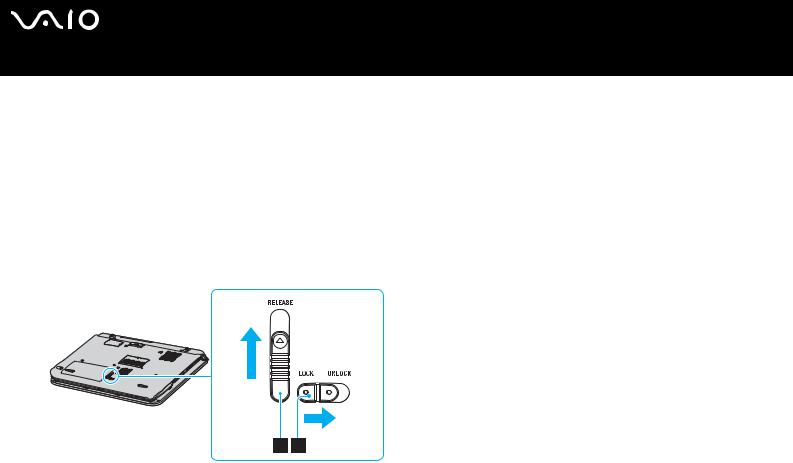
n N
16
Getting Started
Using the Battery Pack
The battery pack supplied with your computer is not fully charged at the time of purchase.
Installing the Battery Pack
To install the battery pack
VGN-A series models
1Turn off your computer and close the LCD screen lid.
2Slide the LOCK/UNLOCK switch (1) on the bottom of the computer to the UNLOCK position.
3Slide the RELEASE switch (2) on the bottom of the computer to the RELEASE position.

n N
17
Getting Started
4Remove the battery compartment cover.
5Slide the battery in the battery compartment cover.
6Turn over the battery attached to the battery compartment cover.
7Insert the tab on the battery compartment cover into the notch, and push the battery down into the compartment until it clicks into place.
8Slide the LOCK/UNLOCK switch to the LOCK position to secure the battery on the computer.
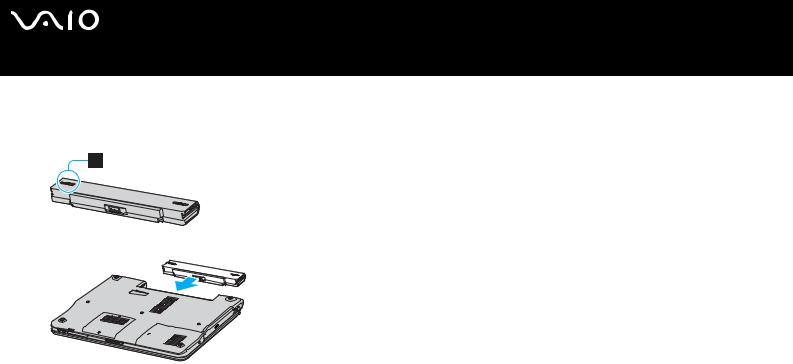
n N
18
Getting Started
VGN-FS series models
1Turn off your computer and close the LCD screen lid.
2Slide the lock switch (1) to the UNLOCK position.
3 Slide the battery into the battery compartment until it clicks into place.
4 Slide the lock switch (1) to the LOCK position to secure the battery on the computer.
When the computer is directly connected to AC power and has a battery pack installed, it uses power from the AC outlet.

n N
19
Getting Started
Charging the Battery Pack
The battery pack supplied with your computer is not fully charged at the time of purchase.
To charge the battery pack
1Install the battery pack.
2Connect the AC adapter to the computer.
The computer automatically charges the battery (the battery indicator light flashes in a double blink pattern as the battery charges).
Battery indicator light status |
Meaning |
|
|
On |
The computer is using battery power. |
|
|
Blinks |
The battery is running out of power. |
|
|
Double blinks |
The battery is charging. |
|
|
Off |
The computer is using AC power. |
|
|

n N
20
Getting Started
When the battery is running out of power, both the battery and power indicator lights blink.
Keep the battery pack in the computer while it is directly connected to AC power. The battery pack continues to charge while you are using the computer.
If the battery level falls below 10%, you should either attach the AC adapter to recharge the battery or shut down your computer and install a fully charged battery.
The battery pack supplied with your computer is a lithium ion battery and can be recharged any time. Charging a partially discharged battery does not affect battery life.
The battery indicator light is on while you use the battery pack as a power source. When the battery life is nearly depleted, both the battery and power indicator lights start flashing.
For some software applications and some peripheral devices, your computer may not enter Hibernate mode even when battery life is low. To avoid loss of data when using battery power, you should save your data frequently and manually activate a power management mode, such as Standby or Hibernate. If the battery wears out when your computer enters Standby mode, you will lose any unsaved data. Going back to the previous work state is impossible. To avoid loss of data, you should save your data frequently.
When the computer is directly connected to AC power and has a battery pack installed, it uses power from the AC outlet.
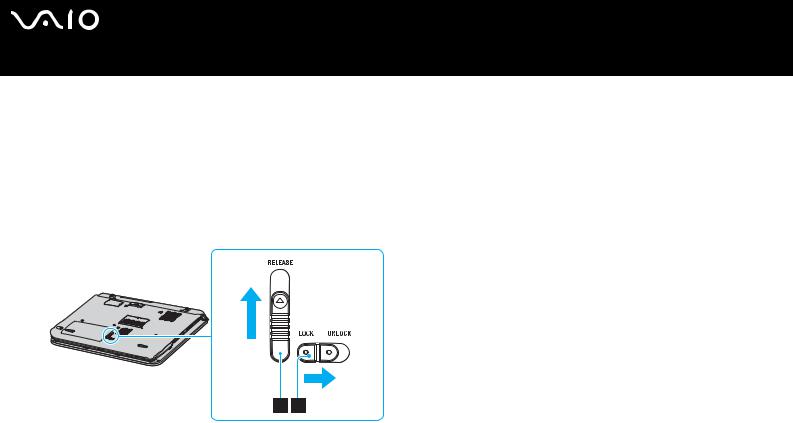
n N
21
Getting Started
Removing the Battery Pack
To remove the battery pack
VGN-A series models
1Turn off your computer and close the LCD screen lid.
2Slide the LOCK/UNLOCK switch (1) on the bottom of the computer to the UNLOCK position.
3Slide the RELEASE switch (2) on the bottom of the computer to the RELEASE position. The right edge of the battery compartment cover is pushed up.
4Raise the edge to remove the battery compartment cover.
5Open the tabs on the battery compartment cover to release the battery and remove it from the battery compartment cover.
6Insert the two tabs on the battery compartment cover diagonally into the notches and push the cover into the compartment until it clicks into place.
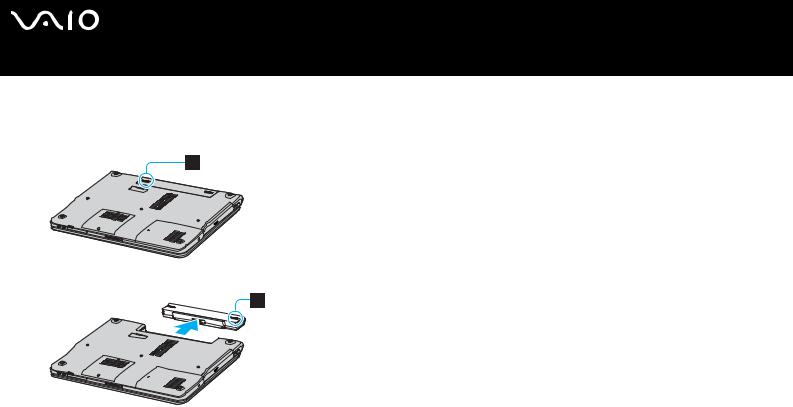
n N
22
Getting Started
VGN-FS series models
1Turn off your computer and close the LCD screen lid.
2Slide the lock switch (1) to the UNLOCK position.
3 Slide and hold the release latch (2) and slide the battery away from the computer.
You may lose data if you remove the battery pack while the computer is on and not connected to the AC adapter or if you remove the battery while the computer is in Standby mode.

n N
23
Getting Started
Shutting Down Your Computer Safely
To avoid losing unsaved data, be sure to shut down your computer properly, as described below.
To shut down your computer
1Turn off any peripherals connected to your computer.
2Click Start and then Turn Off Computer. The Turn off computer window appears.
3Click Turn Off.
4Respond to any prompts warning you to save documents or to consider other users and wait for your computer to turn off automatically.
The power indicator light turns off.
See the printed Troubleshooting Guide if you have problems shutting down your computer.

n N
24
Using Your VAIO Computer
Using Your VAIO Computer
Once you have read and followed the information in the printed Specifications sheet, you can start using your computer safely and confidently.
Read on to get the most out of using your VAIO computer.
Using the Keyboard (page 25)
Using the Touch Pad (page 27)
Using Special-function Buttons (page 28)
Using the Optical Disc Drive (page 30)
Using the TV Function (on Selected Models Only) (page 38)
Using PC Cards (page 39)
Using the Memory Stick Media (page 43)
Using the Internet (page 47)
Using Wireless LAN (WLAN) (page 48)
Using the Bluetooth Functionality (on Selected Models Only) (page 57)

n N
25
Using Your VAIO Computer
Using the Keyboard
Your keyboard is very similar to a desktop computer's, but has additional keys that perform model-specific tasks.
For more information on the standard keys, see Windows Help and Support Centre and click on the Customizing your computer link.
The VAIO-Link web site (www.vaio-link.com) also contains glossary information to help you use the keyboard.
Combinations and Functions with the Fn Key
Combinations/Feature |
Functions |
|
|
|
|
Fn + % (F2): speaker switch (VGN-FS series only) |
Turns on and off the built-in speakers and the headphones. |
|
|
|
|
Fn + 2 (F3/F4): speaker volume (VGN-FS series only) |
Adjusts the built-in speaker volume. |
|
|
|
To increase volume, press Fn+F4 and then M or ,, or keep pressing Fn+F4. |
|
|
To decrease volume, press Fn+F3 and then m or <, or keep pressing Fn+F3. |
|
|
|
Fn + 8 (F5/F6): brightness control |
Adjusts the brightness of the LCD. |
|
|
|
To increase lightness intensity, press Fn+F6 and then M or ,, or keep pressing Fn+F6. |
|
|
To decrease lightness intensity, press Fn+F5 and then m or <, or keep pressing Fn+F5. |
|
|
|
Fn + |
/T (F7): switch to the external display |
Toggles between the LCD, external device (e.g. monitor) and both LCD and external device. |
|
||
|
|
|

n N
26
Using Your VAIO Computer
Combinations/Feature |
Functions |
Changes the screen resolution to magnify/restore the screen view.
Fn + (F10): zoom (VGN-FS series only)
The default resolutions of the standard view and the magnified view are as follow: Standard view: 1280 x 800 pixels
Magnified view: 1024 x 600 pixels
The magnified view is not as clear as the standard view, as it is implemented by applying a lower resolution to the LCD screen with a higher resolution.
This key combination is disabled during video playback. Make sure to quit such software before pressing the key combination.
This key combination may not work with graphic images as it magnifies the screen view by changing the resolution.
The location and size of software windows may change when the screen view is magnified or the standard view is restored because pressing this key combination changes the resolution.
When the LCD screen view is magnified, switching the view to the external display disables the function and restores the standard view.
Fn +  (F12): Hibernate
(F12): Hibernate
Provides for the lowest level of power consumption. When you execute this command, the states of the system and of the peripheral devices are written to the hard disk and the system power is turned off. To return the system to its original state, use the power switch to turn on the power.
For details on power management, see the section Using the Power Saving Modes (page 122).
Some functions are not available until Windows is launched.

n N
27
Using Your VAIO Computer
Using the Touch Pad
The keyboard contains a cursor-pointing device, your touch pad (1). You can point to, select, drag, and scroll objects on the screen using the touch pad.
|
|
|
|
|
|
|
|
|
Action |
Description |
|
|
|
|
|
|
Point |
Slide one finger on the touch pad to place the pointer (2) on an item or object. |
|
|
|
|
|
|
Click |
Press the left button (3) once. |
|
|
|
|
|
|
Double-click |
Press the left button twice. |
|
|
|
|
|
|
Right-click |
Press the right button (4) once. In many applications, this action displays a shortcut menu. |
|
|
|
|
|
|
Drag |
Slide one finger while pressing the left button. |
|
|
|
|
|
|
Scroll |
Move your finger along the right edge of the touch pad to scroll vertically. Move your finger along the bottom to scroll |
|
|
|
|
horizontally (the scroll function is available only with applications that support a touch pad scroll feature). |
|
|
|
|
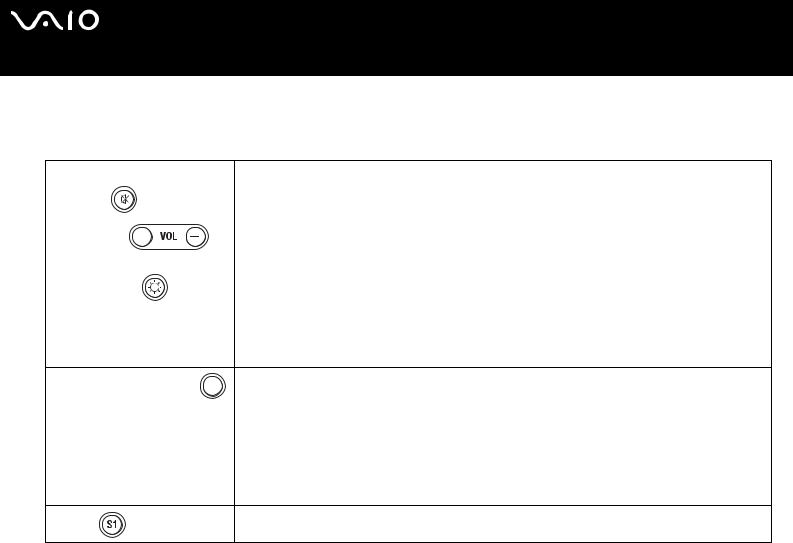
n N
28
Using Your VAIO Computer
Using Special-function Buttons
Your VAIO computer is provided with special buttons to help you use specific functions of the computer.
VGN-A series models
Special-function button |
Functions |
|||
|
|
|
|
|
|
|
|
Turns on and off the volume. The LED turns on when the volume is turned off. |
|
Mute button |
|
|||
|
|
|
|
|
|
|
|
Increase and decrease the volume. |
|
|
|
|||
Volume buttons |
|
|
|
|
(Volume down and Volume up) |
|
|||
|
|
|
|
|
|
|
|
You can increase and decrease the brightness intensity. When the screen is on maximum brightness intensity, the |
|
Brightness button |
LED turns on. |
|||
Auto luminance sensor: |
||||
|
|
|
||
|
|
|
By default, the light sensor senses the brightness from outside and the display brightness is adjusted accordingly. |
|
|
|
|
This setting applies only when the display is set to automatic brightness mode. Press the brightness button to set |
|
|
|
|
the display to automatic brightness mode. You can adjust the general level of the automatic brightness mode in |
|
|
|
|
Setting Up Your Computer with VAIO Control Center (page 120). |
|
Changes the image resolution in all applications, except in those that use the DVD player.
Magnify screen button (Zoom)  : The default resolutions of the standard view and the magnified view depend on the model as listed below. For the type of LCD screen equipped with your computer, see LCD screen in the printed Specifications sheet.
: The default resolutions of the standard view and the magnified view depend on the model as listed below. For the type of LCD screen equipped with your computer, see LCD screen in the printed Specifications sheet.
Models with the WUXGA LCD screen Standard view: 1920 x 1200 pixels Magnified view: 1280 x 768 pixels
Models with the WXGA+ LCD screen Standard view: 1440 x 900 pixels Magnified view: 1024 x 600 pixels
|
The S1 button, by default, launches the VAIO Zone software. You also can link to this shortcut button another |
S1 button |
action that you execute often. See Setting Up Your Computer with VAIO Control Center (page 120). |
|

n N
29
Using Your VAIO Computer
When an external display is connected to your computer, the Magnify screen button is disabled. The magnified view is not as clear as the standard view.
Pressing the Magnify screen button changes the resolution, thus may cause a defect to any running software that does not support change in resolution. Make sure to quit such software before pressing the Magnify screen button.
The Magnify screen button may not work with graphic images as it magnifies the screen view by changing the resolution.
The location and size of software windows may change when the screen view is magnified or when the standard view is restored. When the LCD screen view is magnified, switching the view to the external display disables the function and restores the standard view.
VGN-FS series models
Special-function button |
Functions |
|
|
|
By default, the S1 button turns on and off the volume and the S2 button toggles the display output between the |
S1/S2 buttons |
LCD and external device. You can also link to these shortcut buttons another action that you execute often. See |
|
Setting Up Your Computer with VAIO Control Center (page 120). |
|
|
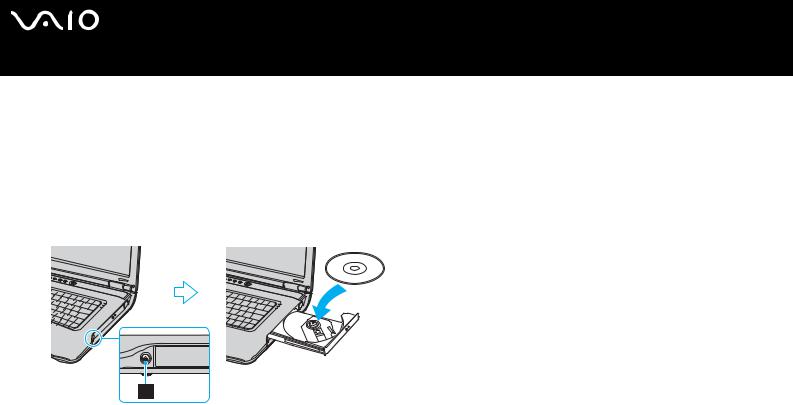
n N
30
Using Your VAIO Computer
Using the Optical Disc Drive
Your computer is equipped with an optical disc drive.
To insert a disc
1Turn on the computer.
2Press the drive eject button (1) to open the drive. The tray slides out.
3Place a disc in the middle of the tray with the label side facing up until the disc clicks into place.
4 Close the tray by pushing it in gently.
!
Do not remove the optical disc when the computer is in a power saving mode (Standby or Hibernate). Doing so may cause the computer to malfunction.
